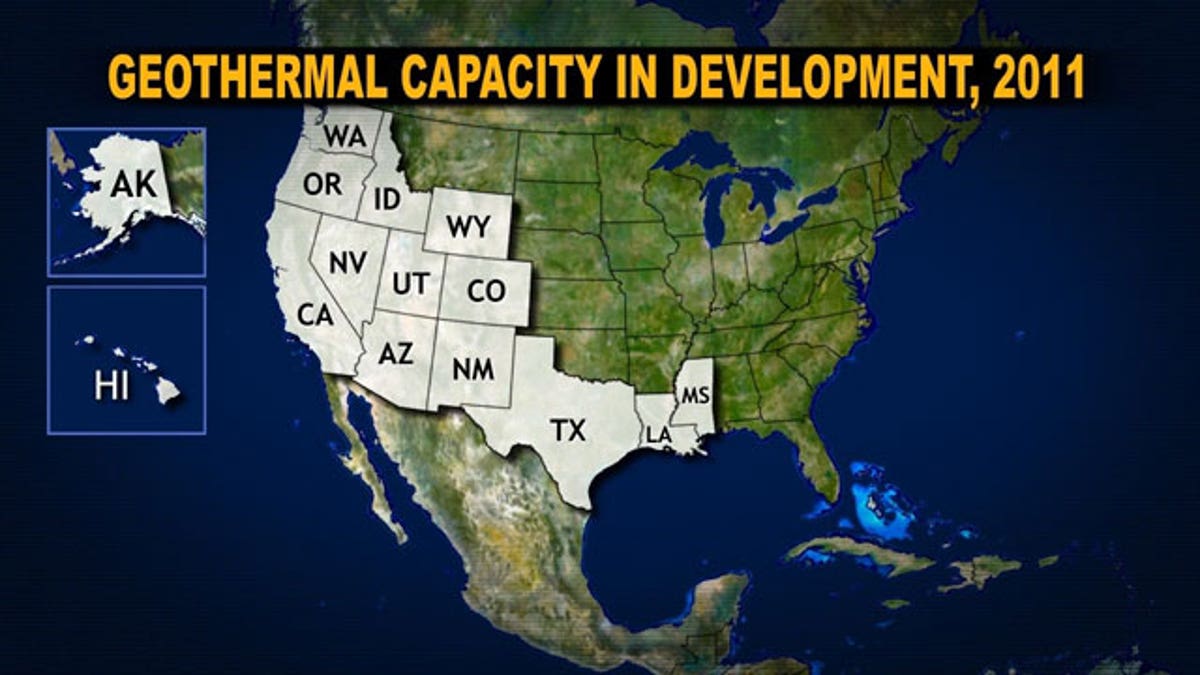
Geothermal energy is essentially free heat that comes from under your feet, and according to the annual report by the Geothermal Energy Association, the United States is using more of it.
"Very basically, it's heat from the Earth that's caused by radioactive decay, volcanism, all that hot source from the center of the Earth," says John Lund, Principal Engineer of the Geothermal Program for the National Renewable Energy Laboratory,
In a recent statement on this renewable energy source, the GEA wrote, "In 2011, the geothermal industry is producing clean power in nine states and developing projects across 15 states... with the total number of geothermal projects... increasing 12%." Additionally, the generation of geothermal energy in the U.S. is enough to power over two million homes.
Dr. Lund is not only one of the nation's foremost geothermal experts, he uses it to power his home. "To heat my house, my hot water, my hot tub, everything, (for) ten dollars a month." Lund uses what's known as a geothermal exchange pump, buried several hundred feet below ground in his backyard for his home. Pumps are a localized system that uses the heat of the ground water, through an assemblage of pipes to bring up the extreme warmth of what's beneath the surface. They can be used anywhere in the world.
"Right now," says Al Wallace, president of the Energy Environmental Corporation, "ground source heat pumps is the fastest growing form of heating and cooling in the United States." The central part of the country is already pretty familiar with geothermal pumps, but because of the initial investment and lack of understanding by homeowners, it takes some educating for other folks to come on board. "I think the reason people don't buy ground source heat pumps is they're...(not) familiar with the technology and implementing systems that they're comfortable with, which is basically the same technology we've had since the 1950's or 60's."
Additionally, Wallace says, in comparison to the most energy efficient traditional home furnaces, geothermal exchange's power blows the competition away. "For most furnaces or gas appliances, the most efficiency is 98 to 99 percent. That means for every one kilowatt or every dollar you pay in energy you get 98 cents back. With a ground source heat pump...for every dollar you spend on heating or cooling you get five dollars worth of heating or cooling in the heating pump."
Folks get power from the heat of the Earth in two ways: heat pumps and power plants. The latter is not something everyone can access, because the location of production facilities are largely where we can see heat rising from the crust (think The Geysers of California). That is slowly changing.
Karl Gawell, Executive Director of the GEA says, "The industry is growing now, because over the past decade both the federal and state government have put in place laws and policies to really promote clean energy". Gawell adds, "And that's helped to overcome the initial problems with geothermal, which are: it's expensive and it's risky to develop these sites." In order to access our subterranean furnace, exploration and oil and gas size drilling is required. But with recent U.S. Department of Energy financial incentives, like loan guarantee programs and grants, innovation and technology are making expansion possible.
"Because if we can make some breakthroughs in that area then geothermal could move much more rapidly across the country." Right now, Gawell says today geothermal is probably one half of one percent of the United States power production, mostly in California and Nevada. In the future, industry insiders say it could be five to ten percent.
First, the average American needs to know it's there, says Gawell. "Frankly I think most people think the ground is cold where the center of the Earth is extremely hot, and it in fact is an energy resource that we can tap almost anywhere in the United States and around the world"
In Elizabeth, Colorado the community of Wild Point Preserve is making use of geothermal pumps as part of its net-zero goals. At this housing development southeast of Denver, homes appear normal. But they're not, because homeowners will always be able to predict what their very lower utility bills will be, explains builder Mark Cucarola of Platinum Homes. "It's different in a lot of different ways, from essentially the design and construction of the home. It's designed to be very efficient (and) tight." In addition to the uber-insulation, solar panels are utilized as well as the geothermal exchange pumps. Once the development reaches 110 homes constructed, it will be the largest high-efficiency neighborhood in the country, according to its developer.
Experts agree the hurdle for geothermal is the upfront cost - be it localized pumps or as power plants, but as the price of fossil fuels rise, so does the appetite for geothermal. The comforting this about it, Lund says with an acknowledged knock on competing renewables, is it's always there.
"It runs when the sun doesn't shine and the wind doesn't blow."




















